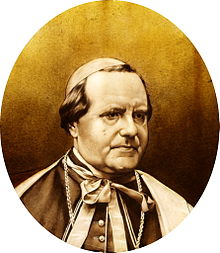Benoît-Marie Langénieux
Benoît-Marie Langénieux (born October 15/16, 1824 in Villefranche-sur-Saône , † January 1, 1905 in Reims ) was a French clergyman, Archbishop of Reims and cardinal of the Roman Church .
Life
Early years
Benoît-Marie Langénieux came from a middle-class family. When he was eight years old, he moved with his family to Paris , where his father died shortly afterwards.
Langénieux first attended the Minor Seminary of Saint-Nicolas du Chardonnet in Paris, where the later Cardinals Charles Martial Lavigerie and Joseph Alfred Foulon were his classmates. From 1846 to 1857 he was the preceptor in Saint-Servant ( Brittany ). In October 1847 he entered the seminary of Saint-Sulpice in Paris to study theology there. He was ordained deacon on May 25, 1850 and was incardinated in the clergy of the Archdiocese of Paris . As Vicar of Saint-Roch , he continued his theology studies at the Sorbonne , where he obtained the Baccalaureus degree .
Church career
priest
On December 21, 1850, he received the sacrament of ordination through Marie Dominique Auguste Sibour , the Archbishop of Paris , in the Notre-Dame de Paris cathedral . In Paris he was still vicar of the parish Saint-Roch in Paris from 1850 to 1873, on November 1, 1863 he was vice promoter and later promoter of the archbishop's curia. On March 15, 1863, he was appointed pastor of the large parish of Saint-Ambroise and on January 29, 1868, he was appointed pastor of Saint-Augustine , where he distinguished himself as an outstanding preacher. At the request of Emperor Napoleon III. he gave the sermons of Lent in 1870 in the court chapel of the Tuileries . He became Archdeacon of the Metropolitan Chapter and Vicar General on November 28, 1871. The French government proposed him on July 24, 1873 for the bishopric of Tarbes , despite the strong concerns expressed by the Apostolic Nuncio Flavio Chigi .
bishop
On July 25, 1873, Benoît-Marie Langénieux was elected Bishop of Tarbes. The episcopal ordination donated him on 28 October 1873 in the Notre Dame Cathedral in Paris Joseph Hippolyte Guibert , Archbishop of Paris, co-consecrators were Frederic de Marguerye , formerly Bishop of Autun , and Jacques Jean Card , Titular Bishop of Ceramus . Langénieux chose as a motto: Vivat in me Christus (“Christ lives in me”; cf. Gal 2,20 EU ).
On November 17, 1874 he was proposed by the President of the Republic of France, Patrice de Mac-Mahon , Duke of Magenta, for the Archbishopric of Reims and on December 21, 1874 promoted to Archbishop of Reims. On February 19, 1875, Langénieux became Papal Assistant to the Throne .
cardinal

In the consistory of June 7, 1886 created Pope Leo XIII. Langénieux as cardinal. He received the cardinal's hat on March 17, 1887, at the same time he was assigned the title church of San Giovanni a Porta Latina .
Langénieux was a close confidante of Pope Leo XIII, who consulted him regularly on the affairs of the Roman Catholic Church in France. He took part in the 1903 conclave in which Pope Pius X was elected.
death
Langénieux died on New Year's Day 1905 in his episcopal city of Reims and was buried in the local cathedral .
effect
As archbishop of Reims Langénieux promoted the aspirations for beatification and canonization of Joan of Arc and supported this by eloquent eulogy to the "Joan of Arc" 1885th
After his elevation to cardinal he was often referred to as Cardinal des ouvriers (cardinal of the workers).
Works
- Declaration of the Cardinaux et exposé de la situation faite à l'église de France (1892)
- Lettre au President de la République (1904)
literature
- Martin Bräuer: Handbook of the Cardinals 1846–2012. Walter de Gruyter, Berlin 2014, ISBN 978-3-11-026944-4 , p. 139.
- Joseph Sollier: Benoit-Marie Langénieux . In: Catholic Encyclopedia , Volume 8, Robert Appleton Company, New York 1910.
Web links
- Benoît-Marie Langénieux. In: Salvador Miranda : The Cardinals of the Holy Roman Church. ( Florida International University website), accessed December 24, 2015.
- Entry on Benoît-Marie Langénieux on catholic-hierarchy.org ; Retrieved December 25, 2015.
| predecessor | Office | successor |
|---|---|---|
| Jean-François Landriot |
Archbishop of Reims 1874–1906 |
Louis Luçon |
| Pierre-Anastase Pichenot |
Bishop of Tarbes 1873–1874 |
César-Victor-Ange-Jean-Baptiste Jourdan |
| personal data | |
|---|---|
| SURNAME | Langénieux, Benoît-Marie |
| BRIEF DESCRIPTION | French clergyman, Archbishop of Reims and Cardinal of the Roman Church |
| DATE OF BIRTH | October 15, 1824 or October 16, 1824 |
| PLACE OF BIRTH | Villefranche-sur-Saône |
| DATE OF DEATH | January 1, 1905 |
| Place of death | Reims |

